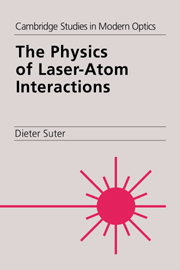Book contents
- Frontmatter
- Contents
- Preface
- Symbols and abbreviations
- 1 Introduction
- 2 Two-level atoms
- 3 Three-level effects
- 4 Internal degrees of freedom
- 5 Optical pumping
- 6 Optically anisotropic vapours
- 7 Coherent Raman processes
- 8 Sublevel dynamics
- 9 Two-dimensional spectroscopy
- 10 Nonlinear dynamics
- 11 Mechanical effects of light
- References
- Index
4 - Internal degrees of freedom
Published online by Cambridge University Press: 13 October 2009
- Frontmatter
- Contents
- Preface
- Symbols and abbreviations
- 1 Introduction
- 2 Two-level atoms
- 3 Three-level effects
- 4 Internal degrees of freedom
- 5 Optical pumping
- 6 Optically anisotropic vapours
- 7 Coherent Raman processes
- 8 Sublevel dynamics
- 9 Two-dimensional spectroscopy
- 10 Nonlinear dynamics
- 11 Mechanical effects of light
- References
- Index
Summary
The two- and three-level model systems considered in the preceding sections can describe a wide range of phenomena. On the other hand, these models are purely mathematical constructs that lack physical content. The connection to physical systems is arbitrary and must be made separately in each case. In this chapter, we take the first step in this direction: We discuss the internal degrees of freedom that an atom has available. By far the most important ones are the electric dipole moment, which is responsible for the coupling to external fields, and the angular momentum, which determines the selection rules for the optical transitions and couples to magnetic fields.
Rotational symmetry
Motivation
The number of energy levels that contribute to the dynamics of a quantum mechanical system is a direct measure of the number of degrees of freedom required for a full description of the system. The systems in which we are interested always include electric dipole moments – the degrees of freedom that couple to the radiation field. The second most important contribution is the magnetic dipole moment associated with the atomic angular momentum. Electric and magnetic dipole moments are those degrees of freedom that couple to external fields. Other degrees of freedom do not couple strongly to external fields but they may still modify the behaviour of the system and its optical properties.
- Type
- Chapter
- Information
- The Physics of Laser-Atom Interactions , pp. 119 - 159Publisher: Cambridge University PressPrint publication year: 1997



